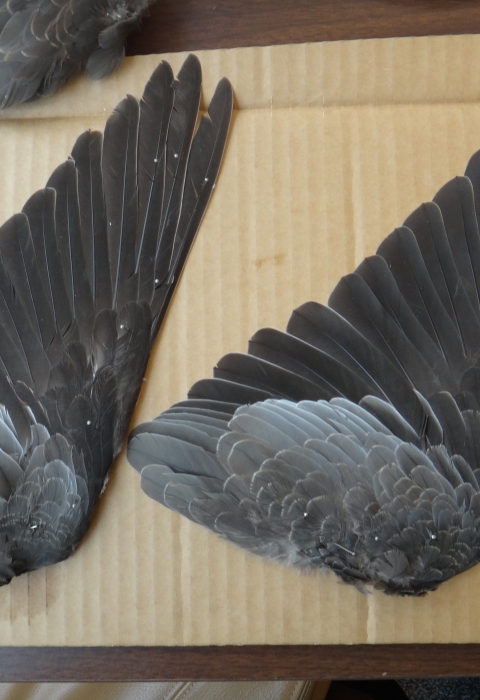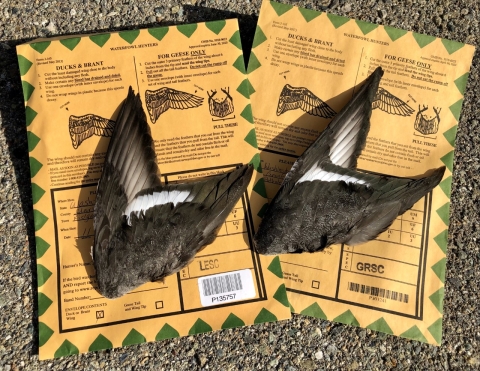I have been the Pacific Flyway Speciator for 6 seasons now - since October 2014. I came to this position immediately after retiring from a 23-year military career, and my principal qualification for this position is that I am a life-long and avid waterfowl hunter.
So what exactly is a speciator you might ask? Well, first I should probably take a step back and explain what the Parts Collection Survey (PCS) is. The PCS, commonly referred to as the Wing Survey, asks a sample of hunters across the country to provide a wing from each duck and specified feathers from every goose they harvest during the upcoming season. These “parts” are used to determine species, age, and sex composition of the annual waterfowl harvest, and provides the necessary information for managers to make decisions about harvest limits. Each hunter is provided prepaid envelopes to mail their parts, which are addressed to the central collection point of their respective flyway. At each of these four locations is a speciator, the person that processes the envelopes, identifies the species, and reports data on each and every wing that is submitted.
Although I spend the majority of the spring and summer on various projects and out in the field doing on-the-ground conservation work, my fall and winter months are consumed by giant mail bags full of duck wings and goose feathers. The flood of mail begins slowly in September with the start of the Alaska hunting season and early goose seasons throughout the lower 48. In the first month I typically receive two to three hundred wings each week, but by the holiday season it can reach two to three thousand! By the time it is all over I will generally have around 30,000 wings.
My average day starts out with sorting through mail bags and organizing the envelopes by state and county. Most of them will be from the states west of the continental divide and Alaska, but I always look forward to those from hunters traveling to states in other flyways. Each sorted stack is then entered into the database by location and date of harvest.
It is always interesting to see where the birds are coming from and having hunted in many different places throughout the United States myself, many of those envelopes bring back fond memories of my days in the marsh. The most memorable envelopes I have ever received came from the Pribilof Islands out in the middle of the Bering Sea: there were 2 common eider, 2 suspected Aleutian green-winged teal, 1 Eurasian wigeon, and a note about the adult male king eiders the hunter was taking to the taxidermist.
Without a doubt, one of the most enjoyable aspects of the job is the speciation process. Although chances are that the envelope contains one of the 6,000+ mallard wings I receive each year, there is a lot of variety in the approximate 30 other species of ducks and geese that come across my desk. It is difficult to say what my favorite wing is because each is so unique. The variation in color with some species is almost comparable to individual fingerprints among humans. I do look forward to certain birds like Barrow’s and common goldeneye, as well as other divers and sea ducks because there are often only one or two feathers on a wing of thousands that separate one species from the other. Every American wigeon wing I get I always flip it over to check the axillary feathers in case it turns out to be one of the dozen or so Eurasian wigeon I receive each year. I truly do love them all but hands down the real prize is the one or two hybrids that show up almost every season. As soon as the wing comes out of the envelope, I can tell that something is just different. It is usually so subtle that I assume the hunter did not even realize what they were holding. A slight difference in color patterns or the size of the wing is often the only indication. Most of those are verified by genetics testing as mallard and northern pintail crosses, but my most memorable was an American green-winged teal and northern pintail cross two years ago. I even have one in the freezer now that I suspect is the same.
The culminating events of the year are the Wingbees, which take place in each of the flyways. Members from the waterfowl conservation and hunting communities come together for these week-long gatherings to make the final determination of species, age, and sex of each wing or feather. Although there is a tremendous amount of work that comes with examining more than 100,000 parts, the atmosphere is closer to that of a family reunion. Young college students and technicians just getting started on their professional journey sitting with those that have attended more than 50! For first time participants, I am the one they see running around moving boxes from here to there and sorting through mountains of wings and paperwork. But from my vantage I can see the big picture – the passing of knowledge from peer-to-peer and from one generation to the next through social connection created by a passion for waterfowl. It is a constant reminder of how fortunate I am to play a small role in something that has been such a huge part of my life.





